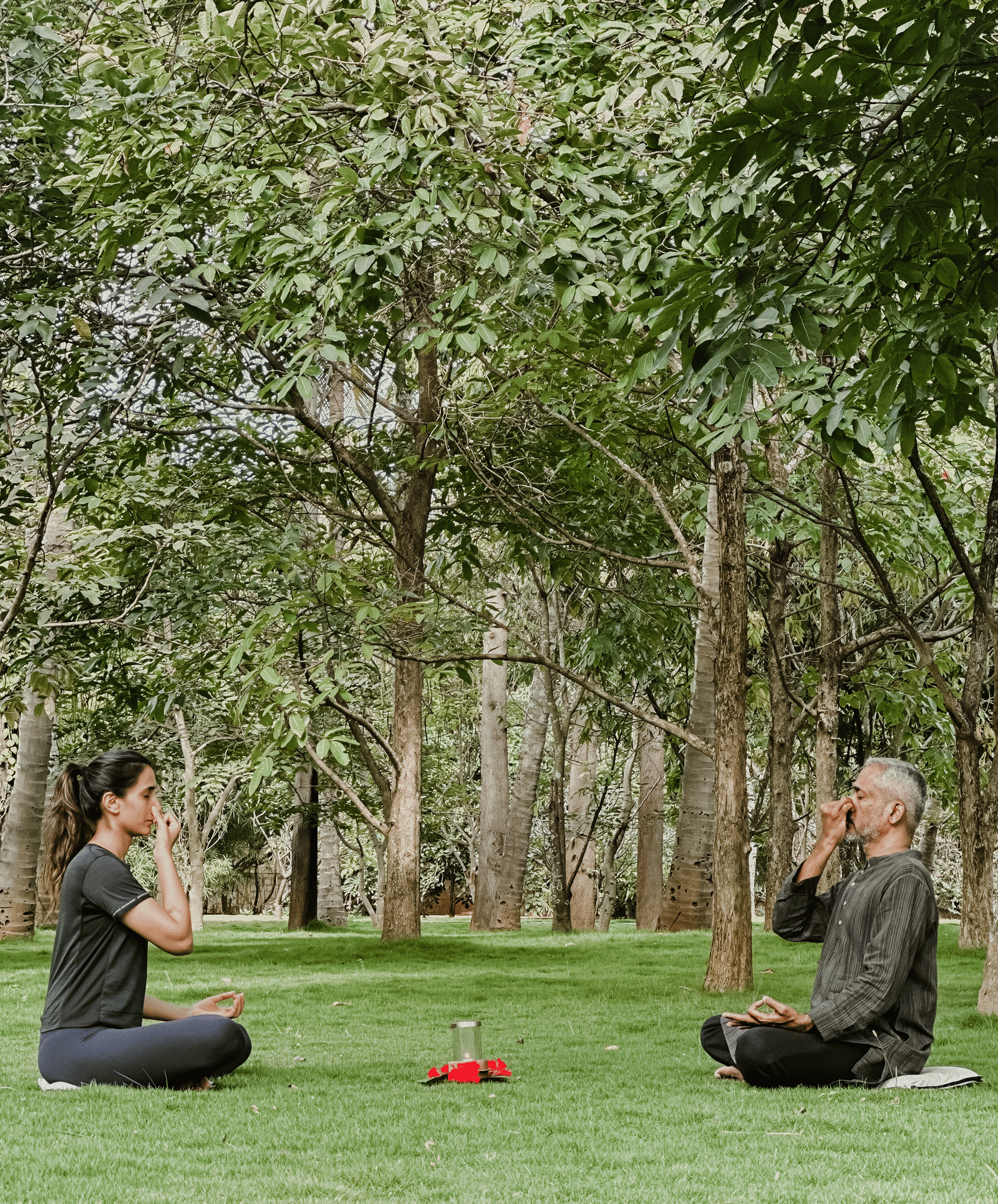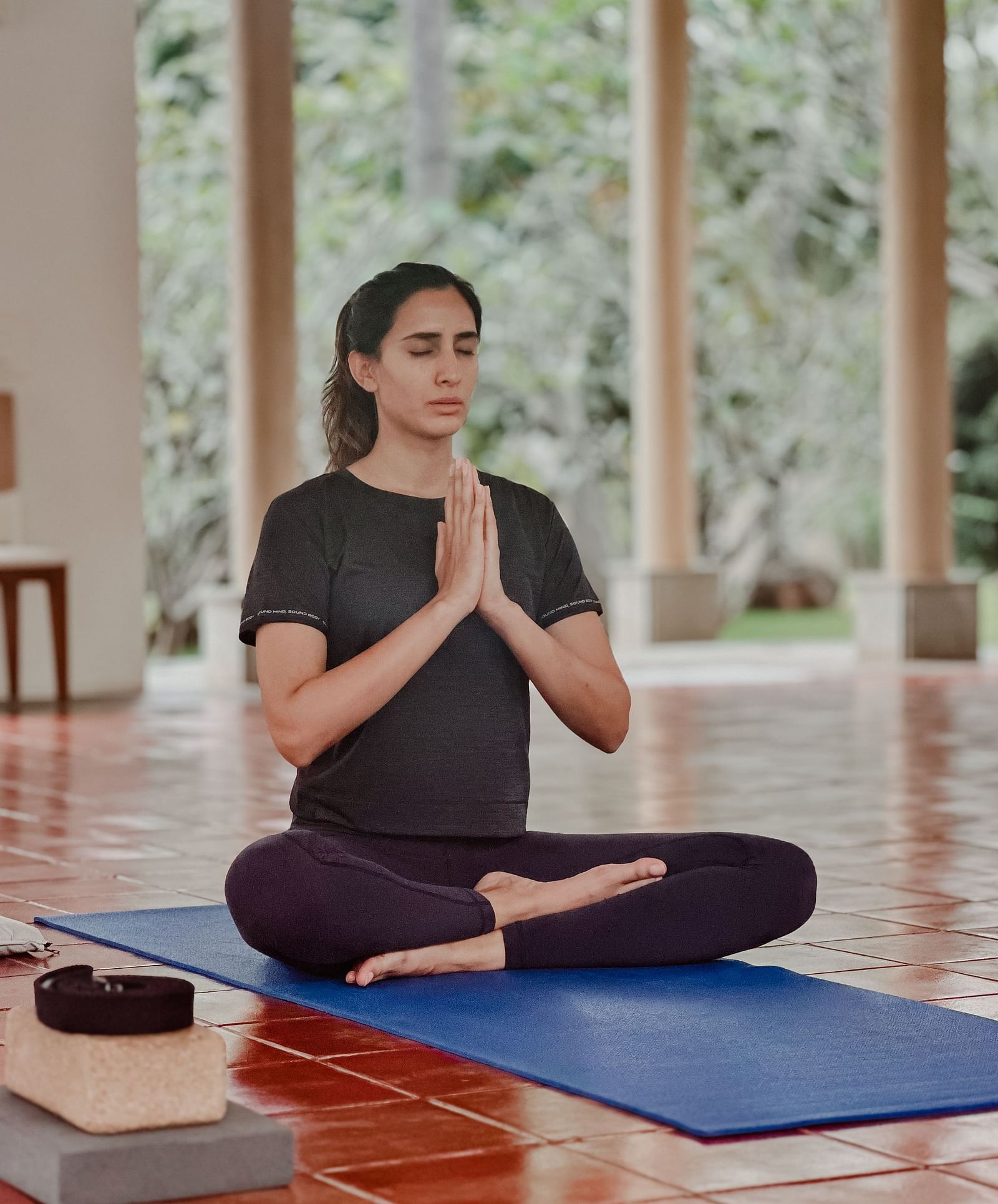
Yoga Retreat Packages
Yoga is often seen as merely a series of physical poses, yet its philosophy reaches far beyond, transcending rituals and embracing all. It brings balance into our lives, calms inner turmoil, fosters excellence, and unlocks the potential within us to become whole. At Shreyas, we guide you on this journey through Yogasana sessions, rooted in the classical traditions of Hatha Yoga and the dynamic flow of Ashtanga Vinyasa. Our teachers, deeply immersed in ancient wisdom and equipped with modern teaching methods, offer classes for every level—beginner, intermediate, or advanced—ensuring a path to self-realisation tailored just for you.
3 Nights (Rates Valid from 1st April 2025 to March 2027)
| Room Type | Garden Tented Cottage/Poolside Cottage | Garden Suite Cottage | ||
|---|---|---|---|---|
| Single | Double | Single | Double | |
| Package Cost | US $1,370 | US $1,830 | US $1,830 | US $2,250 |
| Service Charge | US $137 | US $183 | US $183 | US $225 |
| Net Rate | US $1,507 | US $2,013 | US $2,013 | US $2,475 |
| Inclusions | Sessions | Minutes |
|---|---|---|
| Personalised Yoga Instructional Sessions per Room | 2 | 60 |
| Personalised Pranayama Session per Room | 1 | 60 |
| Personalised Meditation Session per Room | 1 | 60 |
| Personalised Yogic Kriyas | 2 | 15 |
| Rejuvenation Massages per Person (Balinese/Swedish/Thai/Aromatherapy/Abhyanga) | 1 | 60 |
| Service Charges (10%) and Applicable as per Government taxes | - | - |
5 Nights (Rates Valid from 1st April 2025 to March 2027)
| Room Type | Garden Tented Cottage/Poolside Cottage | Garden Suite Cottage | ||
|---|---|---|---|---|
| Single | Double | Single | Double | |
| Package Cost | US $2,380 | US $3,160 | US $3,130 | US $3,860 |
| Service Charge | US $238 | US $316 | US $313 | US $386 |
| Net Rate | US $2,618 | US $3,476 | US $3,443 | US $4,246 |
| Inclusions | Number of Sessions | Minutes |
|---|---|---|
| Personalised Yoga Instructional Sessions per Room | 3 | 60 |
| Personalised Pranayama Sessions per Room | 1 | 60 |
| Personalised Meditation Session per Room | 1 | 60 |
| Personalised Yoga Nidra Session per Room | 1 | 60 |
| Personalised Yogic Kriyas | 3 | 15 |
| Rejuvenation Massages per Person (Balinese/Swedish/Thai/Aromatherapy/Abhyanga) | 2 | 60 |
| Round-trip Airport Transfers | - | - |
| Service Charges (10%) and Applicable as per Government Taxes | - | - |
7 Nights (Rates Valid from 1st April 2025 to March 2027)
| Room Type | Garden Tented Cottage/Poolside Cottage | Garden Suite Cottage | ||
|---|---|---|---|---|
| Single | Double | Single | Double | |
| Package Cost | US $3,460 | US $4,540 | US $4,480 | US $5,480 |
| Service Charge | US $346 | US $454 | US $448 | US $548 |
| Net Rate | US $3,806 | US $4,994 | US $4,928 | US $6,028 |
| Inclusions | Number of Sessions | Minutes |
|---|---|---|
| Personalised Yoga Instructional Sessions per Room | 5 | 60 |
| Personalised Pranayama Sessions per Room | 2 | 60 |
| Personalised Meditation Session per Room | 1 | 60 |
| Personalised Yoga Nidra Session per Room | 1 | 60 |
| Personalised Chakrasuddhi/Trataka Session per Room | 1 | 60 |
| Personalised Yogic Kriyas | 4 | 15 |
| Rejuvenation Massages per Person (Balinese/Swedish/Thai/Aromatherapy/Abhyanga) | 3 | 60 |
| Cooking Sessions on Healthy Vegetarian Cuisine per Room | 1 | 60 |
| Session on Introduction to Naturopathy and Well-being | 1 | 45 |
| Session on Integrating Yoga into Daily Life | 1 | 45 |
| Community Exercise that Involves Farming, Cooking, and Feeding a Group of Children at Nearby Village Schools or Orphanages | 1 | - |
| Nature-based Exercises | - | - |
| Round-trip Airport Transfers | - | - |
| Service Charges (10%) and Applicable as per Government Taxes | - | - |
14 Nights (Rates Valid from 1st April 2025 to March 2027)
| Room Type | Garden Tented Cottage/Poolside Cottage | Garden Suite Cottage | ||
|---|---|---|---|---|
| Single | Double | Single | Double | |
| Package Cost | US $6,620 | US $8,910 | US $8,620 | US $10,730 |
| Service Charge | US $662 | US $891 | US $862 | US $1,073 |
| Net Rate | US $7,282 | US $9,801 | US $9,482 | US $11,803 |
| Inclusions | Number of Sessions | Minutes |
|---|---|---|
| Personalised Yoga Instructional Sessions per Room | 8 | 60 |
| Personalised Pranayama Sessions per Room | 4 | 60 |
| Personalised Meditation Sessions per Room | 2 | 60 |
| Personalised Yoga Nidra Sessions per Room | 2 | 60 |
| Personalised Chakrasuddhi/Trataka Session per Room | 1 | 60 |
| Personalised Yogic Kriyas | 8 | 15 |
| Rejuvenation Massages per Person (Balinese/Swedish/Thai/Aromatherapy/Abhyanga) | 6 | 60 |
| Body Scrub & Mask per person (Salt/Coconut & Honey/Spice/Chocolate/Coffee/Alovera/Fruit) | 1 | 60 |
| Ayurvedic Facial per Person | 1 | 60 |
| Cooking Sessions on Healthy Vegetarian Cuisine per Room | 2 | 60 |
| Sessions on Integrating Yoga into Daily Life | 1 | 30 |
| Personalised Inputs on Naturopathy and Well-being | 1 | 45 |
| A Visit to a Nearby Villages/Temples | - | - |
| City Excursion/Shopping Trip to Bangalore City | 1 | Full Day |
| Community Exercise that Involves Farming, Cooking, and Feeding Groups of Children at Nearby Village Schools/Orphanages | 1 | - |
| Nature-based Exercises | - | - |
| Round-trip Airport Transfers | - | - |
| Service Charges (10%) and Applicable as per Government Taxes | - | - |
21 Nights (Rates Valid from 1st April 2025 to March 2027)
| Room Type | Garden Tented Cottage/Poolside Cottage | Garden Suite Cottage | ||
|---|---|---|---|---|
| Single | Double | Single | Double | |
| Package Cost | US $10,050 | US $13,370 | US $13,030 | US $16,100 |
| Service Charge | US $1,005 | US $1,337 | US $1,303 | US $1,610 |
| Net Rate | US $11,055 | US $14,707 | US $14,333 | US $17,710 |
| Inclusions | Number of Sessions | Minutes |
|---|---|---|
| Personalised Yoga Instructional Sessions per Room | 13 | 60 |
| Personalised Pranayama Sessions per Room | 6 | 60 |
| Personalised Meditation Sessions per Room | 3 | 60 |
| Personalised Yoga Nidra Sessions per Room | 3 | 60 |
| Personalised Chakrasuddhi/Trataka Session per Room | 2 | 60 |
| Personalised Yogic Kriyas | 12 | 15 |
| Rejuvenation Massages per Person (Balinese/Swedish/Thai/Aromatherapy/Abhyanga) | 9 | 60 |
| Body Scrub & Mask per person (Salt/Coconut & Honey/Spice/Chocolate/Coffee/Alovera/Fruit) | 1 | 60 |
| Ayurvedic Facial per Person | 1 | 60 |
| Cooking Sessions on Healthy Vegetarian Cuisine per Room | 3 | 60 |
| Sessions on Integrating Yoga into Daily Life | 2 | 30 |
| Personalised Inputs on Naturopathy and Well-being | 1 | 45 |
| A Visit to a Nearby Villages/Temples | 1 | 2-3 Hours |
| City Excursion/Shopping Trip to Bangalore City | 1 | Full Day |
| Trekking Trip to Nearby Hills (Shivagange Betta/Madhugiri Betta) | 1 | Half Day |
| Community Exercise that Involves Farming, Cooking, and Feeding Groups of Children at Nearby Village Schools/Orphanages | 2 | 3-4 Hours |
| Nature-based Exercises | - | - |
| Round-trip Airport Transfers | - | - |
| Service Charges (10%) and Applicable as per Government Taxes | - | - |
Package Inclusions
- Personalised Yoga Instructional Sessions per room - 2 Sessions for 60 minutes each
- Personalised Pranayama Session per room - 1 Session for 60 minutes
- Personalised Meditation Session per room - Session for 60 minutes
- Personalised Yogic Kriyas - 2 Sessions for 15 minutes each
- Rejuvenation Massages per person (Balinese / Swedish / Thai / Aromatherapy / Abhyanga) - 1 Session for 60 minutes
- Service Charges (10%) and applicable Government taxes
Standard Package Inclusions (Applicable to All the Above Packages)
- Consultations with Ayurveda/Naturopathy doctors.
- Gourmet vegetarian meals (breakfast, lunch, and dinner)/Dosha-specific meal plans/Special Dietary plans as recommended by the doctors/dieticians.
- Scheduled Yoga sessions in the morning (90 minutes) and evening (60 minutes).
- Scheduled daily sound meditation session (45 minutes).
- Scheduled Yogic cleansing Kriyas - Jala Neti/Vaman Dhauti, etc.
- Use of steam, sauna, and Reflexology path as recommended by the doctors.
- Use of all recreational facilities - Swimming pool, Jacuzzi, gym, library and the opportunity to watch one movie per day in the home theatre along with other guests.
Please click here to check out the cancellation policies.
Explore Our Other Packages

Standard Nightly Rates
Check out the nightly rates for each of our accommodations, along with their inclusions.
Explore Package
Wellness Packages
These packages offer a curated itinerary, blending Yoga, meditation, and Pranayama sessions with rejuvenating massages, immersive cooking classes, and more.
Explore Package
Ayurvedic Rejuvenation Packages
Personalised therapies, internal remedies, mindful practices, and dietary guidance are thoughtfully tailored to your needs under these packages.
Explore Package
Silent Retreat Packages
In these packages, embark on a 7-night Mouna Retreat designed to help you step back, introspect, calm the mind, and realign your life goals.
Explore Package
Panchakarma Packages
Healing under each of these packages occurs in three phases: Poorva Karma (preparatory), Pradhana Karma (core procedures), and Paschat Karma (post-treatment rituals).
Explore Package
Detox Packages
These packages combine gentle yoga, Pranayama, meditation, naturopathy treatments, and more to detox and restore your body completely.
Explore Package